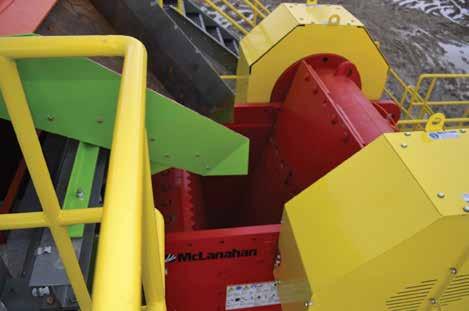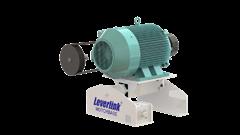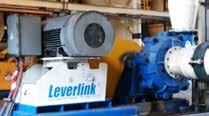
13 minute read
TIPS FOR MAINTAINING CRUSHER EFFICIENCY
from Quarry Apr 2019
by Prime Group
TIPS FOR MAINTAINING EFFICIENCY IN CRUSHING CIRCUITS
Today, the demand for highly specified aggregates means smaller top-sized products are finer than in the past. This means the crushing application has to be just as precise. What are the best tips for crushing materials at the first go, without resizing or stockpiling oversized products?
Efficiency can be defined by the ratio of work done by a machine to the energy supplied to it. To apply what this means to your crusher, in your reduction process you are producing exactly the sizes your market is demanding.
In the past, quarries produced a range of single-size aggregate products up to 40mm in size. However, the trend for highly specified aggregate has meant products have become increasingly finer. Currently, many quarries do not produce significant quantities of aggregate coarser than 20mm; it is not unusual for material coarser than 10mm to be stockpiled for further crushing.
The following are tips and best practices to keep your site crushing efficiently and reduce the number of fines produced.
JAW CRUSHERS A jaw crusher is a compression-type of crusher. Material is reduced by squeezing the feed material between a moving piece of steel and a stationary piece. The setting or the space between those two pieces of steel controls the discharge size. The tighter the setting, the smaller the output size and the lower the throughput capacity. Jaw crushers are mainly used in primary crushing; they are rarely used as a secondary crusher.
As compression crusher, jaws generally produce the coarsest material because they break the rock by the natural inherent lines of weakness. A jaw crusher can be an excellent primary crusher when used to prepare rock for subsequent processing stages such as washing, classifying or a secondary crusher.
General efficiency tips • Grease lubrication systems are preferred over an oil-lubricated system. • An annual radial clearance check of the mainframe bearing should be recorded to track bearing wear. • Minimum discharge setting should not exceed full load amps.
A jaw crusher can be an excellent primary crusher when used to prepare rock for subsequent processing stages.
• Do not crush oversize material against the barrel of the jaw. That area is not considered part of the crushing chamber. • Periodic oil sampling of the bearings is advised, when oil lube is used. • The discharge conveyor and under crusher hopper should be wider than the discharge width of the crusher. • Sufficient tension must be placed on the toggle plate to ensure proper alignment.
Efficiency tip Try to choke-feed any compression-type crusher. Remember, we are using gravity and the weight of the material to push or force material through the chamber. Since in a compression machine the material breaks to fill the air pockets or voids in the chamber, a non-choke chamber will produce a slabbier output than a choke-fed chamber.
Feeding for efficiency Jaw crushers are routinely choke-fed, as this maximises production capacity and ensures particles are uniformly broken. This promotes stone-on-stone crushing, which breaks up flaky or slabbier particles. If you are seeking fewer fines, trickle-feeding material into the jaw crusher could achieve this; however, this would have an adverse effect on particle shape and would also reduce throughput capacity, hindering the crusher’s efficiency. Ideally, the feed rate should not be switched from choke to non-choke, as this would cause problems downstream at the secondary processing plant. In practice, many jaw crushers are fed in this intermittent fashion due to gaps in the delivery of feed material from the quarry. Jaw crusher feed should be pre-screened using a grizzly screen prior to crushing, to remove material finer than the closed side setting (CSS).
Australia’s leading designer and manufacturer of rubber torsion spring motor bases.

subsequent processing plant does not have sufficient capacity to handle the volume of material that would be produced if the jaw crusher were working to capacity.
Crushing setting: Efficiency Ideally, the reduction ratio of a jaw crusher should be 6:1. There are different ways to calculate reduction ratio, but the best way is something called the P 80 factor. The reduction ratio is then calculated by comparing the input feed size passing 80 per cent versus the discharge size that passes 80 per cent. The finer the CSS, the greater the proportion of fines produced. The CSS of a jaw crusher helps determine the nip angle within a chamber, typically 19 to 23 degrees. Too large an angle causes boiling in the crushing chamber; this is where the jaw plates cannot grip onto the rock and it keeps slipping up and down, avoiding being crushed. The nip angle gets flatter as the machine is set tighter.
The settings on a jaw crusher are designed to produce material ideal for secondary crushing. The best particle shape is typically found in material about the same size as the CSS. Smaller sizes will contain a higher proportion of elongated particles because they have passed through the crusher without being touched. Larger sizes may also contain a higher proportion of elongated particles, as they are further from the CSS, which can cause bridging issues in downstream machines. The bottom line is that the best particle shape and performance comes from a choke-fed chamber.
CONE AND GYRATORY CRUSHERS Cone crushers and gyratory crushers are also compression-type machines that crush material between moving and stationary pieces of steel. The setting between the two pieces of steel controls the output. Though the chamber is round in shape, the moving piece of steel is not meant to rotate. Instead a wedge is driven around to create compression on one side of the chamber and discharge opening on the opposite side. Cone crushers are used in secondary and tertiary roles as an alternative to impact crushers, when shape is an important requirement but the proportion of fines produced needs to be minimised. Even though the reduction in fines produced may be only a few percentage points, this could represent a significant amount of material in a large operation and, ultimately, increase an operation’s bottom line and profitability.
General efficiency tips • Be especially careful that a cone crusher does not get ring bounce or chatter. • Variable flow controlled by level sensors will ensure consistent feeding and maintain a full crushing chamber. • Low oil temperature should prevent operation of the unit. • High oil temperature should stop the crusher feed and allow the unit to cool down. After the machine has cooled, further investigation of the high temperature condition is needed before the machine is operated again. • No oil flow should prevent operation of the unit. If the condition occurs during operation, the feed should be stopped immediately, with the crusher stopped 30 seconds later. • Gradations of cone feed and crusher discharge must be monitored as a crushing/reduction performance indicator and as a liner wear indicator. This should be done at least once a month, and more often if required at the site. • Daily inspections below the crusher should be made to ensure
Motorbase -Crushers


Motorbase -Screens, Feeders
Motorbase -Pumps

Chain & Belt Tensioners



no bridging, plugging or foreign material is under the crusher.
Efficiency tips Increasing the CSS in an attempt to reduce the amount of fines produced may have the opposite effect; it may lead to a greater proportion of oversized material, which would need re-crushing in the remaining crushing circuits and would ultimately lead to a higher proportion of fines being produced. The further in the crushing process, the greater the amount of fines produced.
A McLanahan cone crusher.

IN STOCK NOW - HIRE OR BUY
It is critical that a cone-type crusher be choke-fed to produce the best product shape and quality. It is not as important in a jaw, as material is not generally stockpiled after the jaw. Since the cone is in the secondary and tertiary stations, particle shape assisted by a choke-fed chamber is important, as it creates finished products in these stages.
Feeding for efficiency Uniform distribution of feed material around the cone crusher inlet is a good practice. This allows production of a consistent product, as well as efficient, reliable operation of the crusher. Choke-feeding is important for cone crushers because it maintains a good particle shape by facilitating an inter-particle crushing action. Trickle feeding is not the best option because it increases the proportion of flaky material in the crusher product, hindering its efficiency.
It is a good rule to maintain about 10 to 15 per cent of material finer than the CSS in the feed to assist crushing action. More than 10 to 15 per cent will likely cause ring bounce due to the pressures in the chamber.
Efficiency tip Pre-screening of the feed to remove the fines, especially in tertiary crushing, is a good practice; it helps to avoid packing of material in the chamber while maintaining an efficient, effective crushing action and increasing your crusher efficiency.
Crushing setting: Efficiency The liner profiles are designed for a range of product sizes, from extra coarse (EC) to extra fine (EF). The EF liner profile will result in the highest fines proportion for a given cone crusher. It is important to find the right liner for the feed gradation and desired product. If the liner is too large, feed material will drop too far in the chamber before being crushed. Too fine a liner will prevent material from entering the chamber at all.
Monitoring the crushing force as registered
SALES | HIRE | PARTS & SERVICE NSW | VIC | QLD | SA | TAS | PNG
TEREX FINLAY J1480 JAW CRUSHER KEY FEATURES - 10m 3 hopper capacity - Cat C13 328kW (440hp) diesel engine - 1400mmx820mm (55”x32”) Jaques Chamber with reverse action for clearing blockages


Our rental fleet includes the latest equipment from the world’s leading manufacturers.
By routinely choke-feeding jaw crushers, producers promote stone-on-stone crushing, which breaks up flaky or slabbier particles.
through the load on the crusher motors, as well as the pressure on the hydraulic mantle adjustment mechanism, will give forewarning of crusher packing problems before they affect your efficiency.
Efficiency tip The finer the CSS, the greater the proportion of fines produced. The finer setting also lowers throughput volume. It is important to match the CSS of the crusher to the top size of the product to be produced. If the circuit is being closed at 25mm (1”) to produce a 25mm minus product, the crusher should be set at, near or slightly below 25mm.
IMPACT CRUSHERS An impact crusher uses mass and velocity to break down feed material. First, the feed material is reduced as it enters the crusher with the rotating blow bars or hammers in the rotor. The secondary breakage occurs as the material is accelerated into the stationary aprons or breaker plates. Impact crushers tend to be used where shape is a critical requirement and the feed material is not very abrasive. The crushing action of an impact crusher breaks a rock along natural cleavage planes, giving rise to better product quality in terms of shape. The quality of these products makes them ideal for use in highly specified road, stone and concrete aggregate applications.
General efficiency tips • Primary impactors should be of a solid rotor-type to reduce maintenance costs. • Impactors should have a connected wattage sufficient to ensure 110 per cent utilisation. Crusher applications, speed and setting are the factors affecting this. • Impactors should be consistently fed, based on the amperage drawn. • Impactors should be fed evenly over the full width of the rotor. • Precise calculations are needed to achieve the correct material penetration into the rotor. • The efficiency of a secondary or tertiary HSI decreases with the mass and size of the material. The smaller the size, the less effective the crushing.
Efficiency tip Establishing the proper rotational speed of the blow bars or hammers is critical for efficient reduction and production. Also, the angle of the feed plate that introduces the feed material to the rotor assists in the efficiency of the machine. Improper rotor penetration will result in decreased performance.
Feeding for efficiency Size reduction in an impact crusher relies on energy being conveyed into the rock from the rotor, and it begins with your feed. The initial impact is responsible for more than 60 per cent of the crushing action, with the remainder made up of impact against an
Hydraulic Excavators Hitachi and Komatsu 30 to 90 tonnes, Volvo EC480DL
Articulated Dump Trucks Hitachi, Bell 30, 40 & 50 ton capacity & Volvo A45G

Wheel Loaders Komatsu WA500s & WA600s IT28G, IT62Hs. Volvo L260H & Hitachi ZW370, ZW310
Compactors Caterpillar 815Fs & 825Hs
Dozer Caterpillar D6Rs, D6Ts, D7Rs, D8Ts, D9Ts, D10Ts, Komatsu D375A-5
The Right gear in the Right place at the Right time
Delta Rent Pty. Ltd. 577 Plummer Street Port Melbourne Victoria 3207 FOR MORE INFORMATION PLEASE CALL: Richard Khan, General Manager, Office: 1300 793 071 David Hoyle, Territory Manager East Coast, Mobile: 0423 571 081 Phil Aguis, Territory Manager VIC, Mobile: 0418 753 981 Darren Barlow, Territory Manager SA, Mobile: 0418 800 231 www.deltagroup.com.au
adjustable breaker bar and a small amount of inter-particle collision. This is why it is vitally important that the feed arrangement to an impact crusher ensures an even distribution of feed material across the full width of the rotor. This will allow for even distribution of energy into the feed material and uniform wear patterns, ensuring consistent product gradation and power consumption.
Efficiency tips Even feed will ensure the impactor wears uniformly and continues to meet product specifications and ultimate efficiency.
Establishing the proper rotational speed of the blow bars or hammers is critical for efficient reduction and production. Also, the angle of the feed plate that introduces feed material to the rotor assists in the efficiency of the machine. Improper rotor penetration will result in decreased performance.
Crusher setting: Efficiency Size reduction and, ultimately, the crusher setting are directly proportional to the rotor speed; it largely dictates how many fines are produced. Slower rotor speeds can be used as a means of reducing fines, but may result in a product with more oversize or return than is wanted. Slower rotor speeds are preferable as a means of minimising the wear on crusher components and for achieving less fines production and optimal product size. The product grading from an impact crusher will change throughout the life of the wear parts, particularly the impact hammers or blowbars. As the profile of the hammer changes with increased wear, the product grading becomes coarser. Many modern impact crusher installations have a variable speed drive arrangement that allows an increase in the rotor speed to compensate for wear on the impact hammers.
In many impact crushers, a third curtain or crushing chamber can be added to increase reduction in every pass through the machine. This can be important in finer product applications, where the third

chamber can provide the desired output gradation. A third chamber that increases the reduction will also increase the power needs and, normally, the wear cost.
Efficiency tip Decreasing the gap between the hammers and impact curtain increases particle retention in the chamber. This increases the size reduction ratio; however, it also reduces efficiency throughput capacity and increases fines production.
Crushing efficiency begins with common crusher knowledge. Once you have a machine – a jaw, cone/gyratory or impact crusher – how you feed it and how you set it will affect its efficiency. By taking many of the steps outlined above to achieve the best crushing outcome, producers can reduce the amount of fines they produce and save more dollars for their pockets. •
Source: McLanahan Corporation



